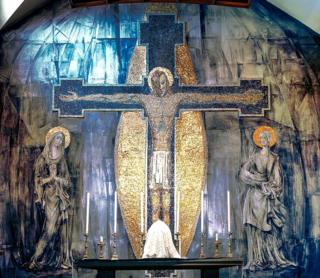Protection sought for George Mayer-Marton's Oldham mural
 Image copyright
G Mayer-Marton Estate
Image copyright
G Mayer-Marton Estate
An "incredibly rare and well-executed" mural by a leading 20th Century artist could be lost if it is not given listed status, a charity has said.
Save Britain's Heritage (SBH) said George Mayer-Marton's The Crucifixion was "increasingly at risk of vandalism, theft and the threat of redevelopment".
A spokesman said the large mosaic and fresco in the Church of the Holy Rosary in Oldham was "nationally significant".
Historic England and the RC Diocese of Salford have been asked to comment.
The church in Fitton Hill was closed as part of a diocese reorganisation in 2017.
At the time, art critics and historians urged officials to save the 25ft (7.5m) 1955 work, which depicts the figure of Christ in tiles of gold against a dark blue cross, flanked by a painted Mary and John the Apostle.
University of Glasgow professor of art history Clare Willsdon told BBC Radio 4 the work was important because of its "unusual" mix of techniques, which create a "symbolic play between spiritual illumination [and] the flatter properties of the paint".
The artist's great-nephew Nick Braithwaite, who has campaigned to protect the work, said he was "still fervently hoping this unique and important mural can be saved... despite the threats currently hanging over it".
An SBH spokesman said the combination of fresco and mosaic was unique in the artist's body of work and though the fresco had been painted over in the 1980s, it remained intact and could be uncovered with careful restoration.
Director Henrietta Billings said the work was "an incredibly rare, well-executed and important mural... by a leading 20th Century artist".
"It needs protection and national recognition through listing," she added.
Architecture blogger Steve Marland, who has visited the building since it was closed, said the work was of "international significance" and its conservation was "imperative".
The Roman Catholic Diocese of Salford, which in 2017 said every effort would be made to save the mosaic, has been contacted for further comment.
George Mayer-Marton
- Born in Hungary in 1897, he served with the Austro-Hungarian army in World War One, before studying art in Vienna and Munich
- Became a senior figure in the Hagenbund, a leading society of Viennese artists, but fled Austria in 1938 to escape Nazi persecution
- Worked as a lecturer for the Arts Council, before joining Liverpool College of Art in 1952 as part of a staff who would go on to teach future Beatles John Lennon and Stuart Sutcliffe
- Designed murals and mosaics for schools and churches, including the Pentecost mosaic in Liverpool Metropolitan Cathedral, until his death in 1960
- His work is held by many British galleries, including The Derby Museum, National Museum of Wales, Cardiff and the Walker Art Gallery in Liverpool.
Source: British Museum
Why not follow BBC North West on Facebook, Twitter and Instagram? You can also send story ideas to northwest.newsonline@bbc.co.uk